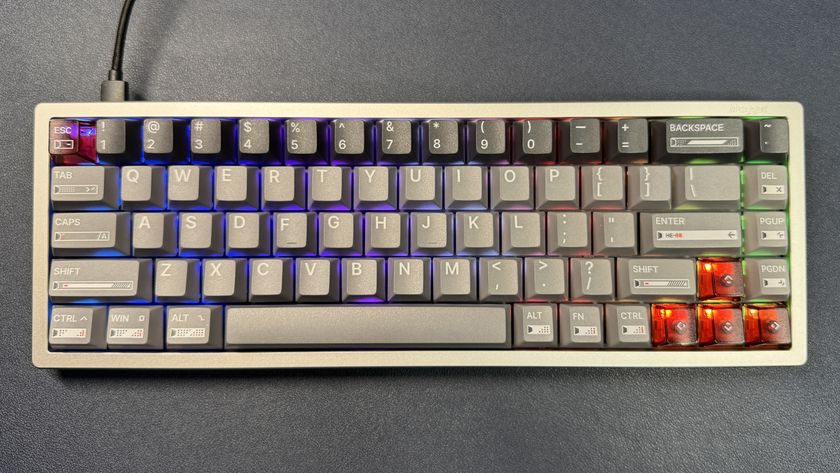Asus Z97M-Plus Motherboard Review
Another day, another mATX Z97 motherboard review. Today's candidate is the Asus Z97M-Plus, which we're comparing to ASRock's Z97M OC Formula and Z97M Pro4.
Why you can trust Tom's Hardware
Test Results
Test Bench Hardware
Benchmark Settings
| 3D Gaming | |
|---|---|
| Battlefield 4 | Version 1.0.0.1, DirectX 11, 100-sec. Fraps "Tashgar"Test Set 1: Medium Quality Preset, No AA, 4X AF, SSAOTest Set 2: Ultra Quality Preset, 4X MSAA, 16X AF, HBAO |
| Grid 2 | Version 1.0.85.8679, Direct X 11, Built-in BenchmarkTest Set 1: High Quality, No AATest Set 2: Ultra Quality, 8x MSAA |
| Arma 3 | Version 1.08.113494, 30-Sec. Fraps "Infantry Showcase"Test Set 1: Standard Preset, No AA, Standard AFTest Set 2: Ultra Preset, 8x FSAA, Ultra AF |
| Far Cry 3 | V. 1.04, DirectX 11, 50-sec. Fraps "Amanaki Outpost"Test Set 1: High Quality, No AA, Standard ATC, SSAOTest Set 2: Ultra Quality, 4x MSAA, Enhanced ATC, HDAO |
| Adobe Creative Suite | |
| Adobe After Effects CC | Version 12.0.0.404: Create Video which includes 3 Streams, 210 Frames, Render Multiple Frames Simultaneosly |
| Adobe Photoshop CC | Version 14.0 x64: Filter 15.7MB TIF Image: Radial Blur, Shape Blur, Median, Polar Coordinates |
| Adobe Premiere Pro CC | Version 7.0.0 (342), 6.61 GB MXF Project to H.264 to H.264 Blu-ray, Output 1920x1080, Maximum Quality |
| Audio/Video Encoding | |
| iTunes | Version 11.0.4.4 x64: Audio CD (Terminator II SE), 53 minutes, default AAC format |
| Lame MP3 | Version 3.98.3: Audio CD "Terminator II SE", 53 min, convert WAV to MP3 audio format, Command: -b 160 --nores (160 kb/s) |
| Handbrake CLI | Version: 0.99: Video from Canon Eos 7D (1920x1080, 25 FPS) 1 Minutes 22 SecondsAudio: PCM-S16, 48000 Hz, 2-Channel, to Video: AVC1 Audio: AAC (High Profile) |
| TotalCodeStudio 2.5 | Version: 2.5.0.10677: MPEG-2 to H.264, MainConcept H.264/AVC Codec, 28 sec HDTV 1920x1080 (MPEG-2), Audio: MPEG-2 (44.1 kHz, 2 Channel, 16-Bit, 224 kb/s), Codec: H.264 Pro, Mode: PAL 50i (25 FPS), Profile: H.264 BD HDMV |
| Productivity | |
| ABBYY FineReader | Version 10.0.102.95: Read PDF save to Doc, Source: Political Economy (J. Broadhurst 1842) 111 Pages |
| Adobe Acrobat 11 | Version 11.0.0.379: Print PDF from 115 Page PowerPoint, 128-bit RC4 Encryption |
| Autodesk 3ds Max 2013 | Version 15.0 x64: Space Flyby Mentalray, 248 Frames, 1440x1080 |
| Blender | Version: 2.68A, Cycles Engine, Syntax blender -b thg.blend -f 1, 1920x1080, 8x Anti-Aliasing, Render THG.blend frame 1 |
| Visual Studio 2010 | Version 10.0, Compile Google Chrome, Scripted |
| File Compression | |
| WinZip | Version 18.0 Pro: THG-Workload (1.3 GB) to ZIP, command line switches "-a -ez -p -r" |
| WinRAR | Version 5.0: THG-Workload (1.3 GB) to RAR, command line switches "winrar a -r -m3" |
| 7-Zip | Version 9.30 alpha (64-bit): THG-Workload (1.3 GB) to .7z, command line switches "a -t7z -r -m0=LZMA2 -mx=5" |
| Synthetic Benchmarks and Settings | |
| 3DMark 11 | Version: 1.0.5.0, Benchmark Only |
| 3DMark Professional | Version: 1.2.250.0 (64-bit), Fire Strike Benchmark |
| PCMark 8 | Version: 1.0.0 x64, Full Test |
| SiSoftware Sandra | Version 2014.02.20.10, CPU Test = CPU Arithmetic / Multimedia / Cryptography, Memory Bandwidth Benchmarks |
Each board is set to stock clocks, Speed Step and energy saving features are enabled, and the CPU fan is set to maximum. I use Windows default "Performance" power option preset for everything except idle power consumption where it gets set to "Balanced."
We're looking for oddities in the bench scores. Boring benchmarks are good benchmarks for motherboards. Dramatic score leads are due to motherboards cheating with hidden clock boosts while a board lagging behind is usually a configuration conflict.
With the Z97M-Plus numbers now in the scoring charts, the last of the ITX boards have dropped off the comparison table. It's just microATX Z97 from here on out.
Synthetic Benchmarks



The Plus shows a small bump in 3DMark 11 physics, but everything else is pretty flat. I'll chalk this up to the odd way the Plus handles Turbo Boost.




We see another anomaly in Sandra Multimedia where the Plus scores a little lower than the rest. Everything else is completely flat. Doing a little math, all the errant scores are almost exactly 5 percent lower. This again suggests the aforementioned Turbo Boost glitch since 4.0 GHz is 5 percent lower than the 4.2 GHz turbo clock the 4790K normally reaches. I think we have our culprit.
Gaming Benchmarks




The Plus falls in line with past gaming results. This is exactly the behavior we love to see in motherboards.
Application and Productivity Benchmarks




Variances of one second are almost always due to rounding. The Plus shows excellent consistency here.
Power and Temperature


Asus has a history of lower power consumption in their motherboards. Finer electrical control in the BIOS allows the CPU to run on less electricity and thus at a lower temperature. A smaller VRM hea tsink means higher temperatures on the power regulation circuitry.
Overall Performance And Efficiency


We always like doing the same amount of work on less electricity. Asus notches a solid efficiency win over the ASRock competitors.
Overclocking Performance



The Plus overclocks the BCLK better than the ASRock boards and can reach basically the same CPU overclocks. Unfortunately, RAM overclocking is hit-and-miss. Both ASRock competitors can push RAM to faster frequencies in both two- and four-module configurations and reach higher bandwidth at the 2666 and 2800 straps. The Plus does score a significant bandwidth victory at DDR3-2400, though, demonstrating much tighter auto timings at the lower frequency.
Stay On the Cutting Edge: Get the Tom's Hardware Newsletter
Get Tom's Hardware's best news and in-depth reviews, straight to your inbox.
-
Non-Euclidean "I gave some meaningless style points to the OCF last time for its sharp colors. I give the same empty points to the Plus by not treating me like a squirrel and thinking stylish anodizing will sway my head."Reply
So apparently anodizing isn't stylish, and doesnt treat you like a squirrel, but when presented with "sharp colors", you sprint outside looking for acorns!
We arent looking for a style review and you admit you are a sucker for one style, but then feel insulted when the next board isnt the style you prefer. That's hypocrisy.
But thanks for the view from Tom's Styleware Guide!
-
Non-Euclidean This board has M2 10Gb/S. That isnt on the specifications and should be. You did imply it, when you said a cable wasnt needed for M2, but it should be on the spec table.Reply
Why wasnt it tested with an M2 drive as the boot drive? -
vertexx Seriously, I kept hitting "refresh" thinking this was some archive from mid 2015. What's the relevance of running a z97 motherboard review now? That ship has sailed.....Reply -
blazorthon ReplyThe first and second SATA ports are not forward-facing even though ports three through six are. I'm not sure why Asus would do this, especially since port one and two are the most likely to be used.
Two SATA slots are forward facing because not all cases are made in such a way that sideways ports can be used conveniently (if at all).
Other than if you're using a SATA M.2 SSD, it doesn't matter at all which SATA ports you use, so whether the 1 and 2 slots are forward facing or 3 and 4 or 5 and 6 makes no difference. 1 and 2 aren't any more necessary to be filled first than any other SATA slots. -
mapesdhs Minor typo re "shroter" at the end of the first page:Reply
"SATA cables are on the shroter side ..."
Blazorthon's right about the SATA ports, one can boot from any of them.
-
RedJaron Reply
I rather like the form factor, one of the reason we're trying to devote some space to it.17354518 said:Micro ATX has become that middle child that gets ignored most of the time.
Try rereading it with your tongue in your cheek. Notice the points are meaningless and they both got the same amount? If a manufacturer wants to gussy up a board with fancy colors and RGB lighting, I will comment on that. If a mfr keeps things strictly business, I will comment on that as well. Neither impacts my final recommendation on the product.17354790 said:So apparently anodizing isn't stylish, and doesnt treat you like a squirrel, but when presented with "sharp colors", you sprint outside looking for acorns!
We arent looking for a style review and you admit you are a sucker for one style, but then feel insulted when the next board isnt the style you prefer. That's hypocrisy.
But thanks for the view from Tom's Styleware Guide!
I didn't say I'm a sucker for anything except good function and value. It seems today there's a trend to make every computer component as fancy looking as possible. Personally I'd rather not pay extra money for fancy anodizing and RGB lighting. Just give me a product that works for as low a price as possible. I'm telling Asus that it doesn't have to dress up a board to get an award from me.
It was on the spec table when I turned it in. Looks like it got lost somehow. I'll get that fixed. Thanks.17354872 said:This board has M2 10Gb/S. That isnt on the specifications and should be. You did imply it, when you said a cable wasnt needed for M2, but it should be on the spec table.
Because the Z97 test bench components need to be kept consistent from one board to another so that the results are properly comparable. Right now we use a 2.5" 840 Pro since not all boards have an M.2 slot.17354872 said:Why wasnt it tested with an M2 drive as the boot drive?
This review was finished a while ago, but we've had so many things in the publication queue, it didn't come out till now. Regardless, just because Skylake is out doesn't mean Haswell is suddenly horrible. Skylake prices are so volatile and inflated right now, global availability still isn't assured, so a cheaper Haswell build is perfectly acceptable for many people right now.17355097 said:Seriously, I kept hitting "refresh" thinking this was some archive from mid 2015. What's the relevance of running a z97 motherboard review now? That ship has sailed.....
How is a forward-facing SATA port less convenient than a perpendicularly mounted one? What mATX case is so incredibly tight around the mboard leading edge that it can't accommodate edge-facing SATA ports? This board is narrower than the mATX spec allows so it actually has more room on the leading edge than a full size mATX board.17355321 said:Two SATA slots are forward facing because not all cases are made in such a way that sideways ports can be used conveniently (if at all).
I understand that port number doesn't matter when they're all SATA 6Gbps and that you can set your boot drive priority in the BIOS. However, for people that like to order their drives according to SATA port, it's annoying. Call me OCD if you want.17355321 said:Other than if you're using a SATA M.2 SSD, it doesn't matter at all which SATA ports you use, so whether the 1 and 2 slots are forward facing or 3 and 4 or 5 and 6 makes no difference. 1 and 2 aren't any more necessary to be filled first than any other SATA slots.
With CPUs getting more power efficient, and with Haswell integrating some power control onto the chip itself, massive VRMs aren't as necessary now as they used to be. I understand it feeling like a cut corner given the board's competition. But at the same time, expecting to go for maximum overclock on a mainstream priced board is unrealistic.17355470 said:4+1 power delivery at over $100? Really? -
heinlein "I prefer windowless cases, and flamboyant colors don't mean anything behind a steel panel. A board only needs a good feature set at a good price to earn my respect."Reply
Very refreshing to read that. When I read tech reviews; some things are important to me like is the layout user friendly, performance/power used, thermals, and noise; things like PCBs with a checkered flag motif or extraneous LEDs are useless to me. It is annoying to find a product that fits my needs and know that it is more expensive than it should be because they decided to add cosmetic items like LEDs.


